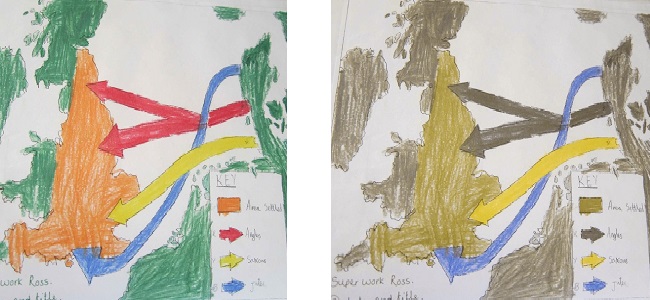Most teachers are aware that there are over 500,000 FTE (full-time equivalent) teachers in England, and that approximately 73.6% are female, but have you ever considered how many of these could be colour-blind? According to colour-blindness (colour vision deficiency – CVD) statistics (8% men and 0.5% women), there are over 11,100 FTE teachers with colour-blindness in England alone. Adding in teaching assistants, 92% of whom are female, increases the total to 15,300 colour-blind FTE teachers / teaching assistants. So how do they go about managing in the school environment?
When Innovate My School asked me to look at colour-blindness from the perspective of colour-blind teachers I was keen to investigate, as this was not an area we have previously considered in detail.
Alan Banks, head of Humanities at The Bishop of Herefordshire’s Bluecoat School kindly agreed to being questioned about his experiences with colour-blindness.
Firstly I asked him about his memories of being a colour-blind pupil.
“Well, I got told off in primary school for colouring in a picture of my sister’s hair in green! And I didn’t pass my Chemistry A Level because there were lots of titrations in the practical; I didn’t know I had CVD then, and so I couldn’t see the colour changes.”

This being a new area for me to investigate, I decided to approach the interview with Alan as a series of formal questions. I found his responses enlightening, and they really make one think about how it might feel to be in his position.
1. You are red/green colour-blind, but did you know that there are different types and severities, ie. what you see could be quite different to what another colour-blind person sees?
No, I didn’t know that back then. I thought all colour-blind people saw the same. I wasn’t aware of the problems red deficients have [confusing red with black] so I hadn’t appreciated that I must have a green deficiency. I thought I had red/green colour-blindness.
2. Do your colleagues know you are colour-blind?
No, only my line managers and people I work closely with.
3. Do those colleagues ever ask you how they might make your working life easier?
No, not really. I have to keep reminding them about the information I can’t access because they always forget.
4. Do they ever ask you about how to support colour-blind pupils?
Only one has ever asked me.
5. Do you think your school should screen for CVD at Year 7 entry?
Yes, it would be really helpful for all the teachers – the school should know who the colour-blind students are.
6. How many CVD pupils have you taught?
I’m not sure. I do always make sure my students know that I am colour-blind, and I look out for signs of students with colour-blindness. I let them come to me and will advise the school and support staff of those that do, but not many come forward.
7. Since the school doesn’t screen for CVD at school entry, most CVD pupils won’t be identified. They don’t tend come forward, even though they know you would be sympathetic. Do you think teachers should expect CVD pupils to speak up?
No, definitely not! I don’t want to admit to my CVD because I don’t want to bother people, and so I try to manage on my own. I have to force myself to speak up when I can’t access information, and my current school is the first where I have actually spoken up. The worst part is what happens after you do – having to explain what you can’t explain, and answer questions you can’t answer. I suspect pupils don’t come forward for the same reasons.
8. Do you think it’s acceptable that you and your pupils with CVD are at a disadvantage?
No.
9. What are the everyday issues you have because of CVD at work?
I often have problems with accessing information in Powerpoints, Excel spreadsheets (to track student information with colour coding) and textbooks. The Microsoft colour wheel makes no sense to me! In a recent faculty meeting, I couldn’t differentiate between pastel colour coding for History and Geography.
Black and white is considered boring by everyone else so they use colour a lot, but I find it difficult to see information in presentations and on the whiteboard. LCD projectors somehow wash out the colours and make them less obvious. I notice my colour-normal colleagues automatically know what the colours are and they don’t have to think about them. It takes me a while to work the colours out.
10. Do you use any tools such as apps and software to help you/your CVD students?
I had no idea there was anything out there to help me - I would love to use the apps but I don’t have access to an iPad at the moment. I just avoid colour in my teaching and use shading instead.
11. What are the most frustrating recurring problems at your current school?
CVD isn’t taken seriously, anywhere - that’s the biggest frustration! In terms of my everyday teaching I find Ordnance Survey sheets difficult to work with as well as maps and graphics which are quite often in pastel colours with no secondary labelling. There are certain publications I avoid because I know I will have problems with them. David Waugh’s books are widely used in Geography teaching, but are difficult for me to use.
I find traffic light assessments almost impossible to distinguish as well as highlighter pens, lights and switches – I can never tell if my monitor is on or on standby! I feel people should be aware of colour-blindness and make information accessible. It’s not a level playing field for colour-blind people because we are just not catered for. For example, as a school when we order stock for the new school year we will include left-handed scissors but not coloured pencils with colour labels!
This was a very illuminating interview, but do all colour-blind teachers have similar experiences?
Thomas Kidman of Beauchamps High School commented on how he copes with being a teacher with CVD.
“I am a deuteranope [severe loss of green vision] science and ICT teacher, so I have experienced all kinds of issues myself in education, both as a student and as a teacher. Luckily, I have a wife who is very supportive, so when I design lessons I am well placed to identify potential problems, and then we both provide solutions.
I specifically design schemes of work that take account of issues of colour-deficiency wherever they may occur. This won't always be successful, as there will be occasions when I don't realise there's a problem because I won't have even noticed some heavy use of colours.

I make a point of discovering who my colour-deficient students are at the beginning of the year by asking them, as it rarely comes up on individual education plans (IEPs).
I also explain to the class that I am colour-deficient, something I love talking about as I find it fascinating, and so do they. It actually leads to a lot of science that gets discussions going.
But the main reason I tell them is that working in a lab causes me no end of trouble, so I need them to know that I will be asking them for help whenever colours become important. All the students I have ever taught are brilliant with their help. They will tell me what colour the worksheets are, what pH we are at, what colour flames we have, what colour the thing is I'm pointing at on the board, etc.
I've met so many colour-deficient people in my life by being so open about it. Normal vision people are really surprised when I tell them, thinking I'm the only one they know, but I'll know a whole load of people around the school whom they talk to regularly who are also colour-deficient. I've helped lots of parents understand their child's condition, as I am able to speak about my experiences and the reasons behind them.
I even found out a previous head teacher was colour-deficient when I told him that the software we had for analysing exam results was incomprehensible for me due to the colour coding. He said he couldn't use it either!”
So now we know that, unfortunately, colour-blind teachers face much greater challenges at work than their colour-normal colleagues. I hope by writing this article that issues such as those raised here will become less prevalent, and CVD teachers and pupils will become better supported in schools in future.
Are you a colour-blind teacher, or do you have any such colleagues? Let us know in the comments.


















